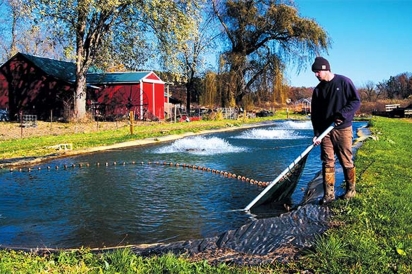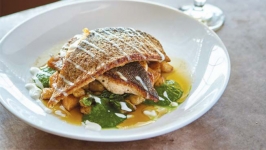Indian Brook Trout Farm Embraces Sustainability
Ask Owen Ballow why he majored in fisheries biology at the University of Michigan, and he’ll look at you as if lobsters were emerging from your ears.
“We’re on the Great Lakes,” he says with a somewhat incredulous grin. “We’re always on the water.”
Like many Michigan natives—Ballow hails from Lincoln Park— he grew up fishing and loving pretty much everything there is to love about lake fish. But after graduating, Ballow found himself selling medical supplies. There was simply no work for a fisheries biology graduate in the state.
After 30 years supplying equipment for cardiologists, the notion for a career shift came to him via a neighbor.
“My wife, Julie, and I have a small farm with artesian water, and my neighbor had a little trout farm. So I put in a well and a pond and started raising fish as a hobby. My younger son, Chris, was going to MSU at the time, in the same major. I started looking for a bigger property with artesian water for him to run as a trout farm.” (Ballow’s older son, Andrew, works as a banker and daughter Olivia is still in high school.)
He extensively researched area hydro-geological maps, looking for conditions that would allow for maximum environmental responsibility. After eight years, he found Indian Brook, a 100-yearold, 90-acre property that had operated as a trout farm for 20 years.
In its previous incarnation, “they raised 20,000 rainbow trout a year,” says Ballow. “We’re up to a million. We’re working seven days a week. There’s a real pent-up demand for locally grown fresh fish.”
That demand comes from area restaurants that include Real Seafood and Zingerman’s Roadhouse, and Grand River Brewery in Jackson, whose Executive Chef Corey Bieber, is passionate about using top-quality local ingredients. After visiting Indian Brook, he was sold.
“Owen’s running a really awesome operation, and since we’re less than two miles away the carbon footprint is extremely low.” Customers have responded so positively to the trout entrée that Bieber has added a smoked trout cake appetizer.
Home chefs can find Indian Brook trout at Busch’s and Plum Markets. “It’s mild, and it doesn’t taste fishy,” says Ballow. Bieber praises the fish’s versatility, but cautions that battering and deep frying it won’t do the fish justice. He recommends a simple dusting of cornmeal and then “crisp it up nicely” in a hot pan.
Anyone concerned about farm-raised fish vs. wild caught can rest assured that Ballow holds his farm to the highest standards: no Frankenfish here.
“You have to differentiate the types of fish farming,” he explains. “The most controversial [types] use net pens—basically floating cages—in public bodies of water. All the fish waste goes into the environment, and the farm-raised fish can escape into the wild, and introduce diseases. Other types might be less problematic, but still have the waste issue.”
Ballow and his team raise the fish in pristine conditions. Eggs come from Washington state, Ontario and northern Michigan, and are delivered in a state of suspended animation. They are referred to as “eyed”: a red dot indicating fertilization sits in the center of each egg, like a pupil. They’re carefully placed in a tower holding a series of trays, each of which can contain about 7,000 eggs.
Oxygenated water churns through the trays, gently tumbling the eggs. After approximately two weeks, the eggs develop into tiny fish that migrate to a tank that serves as home during the “swim-up” phase. “We have to train them to eat,” says Ballow, “so we feed them 18 times a day.”
As trout increase in size, they move to larger and larger tanks before eventually being placed in outdoor ponds, where they’re harvested by nets and then placed into cold non-oxgenated water that effectively numbs them into a state of suspended animation. Their lives end painlessly.
To feed his fish, Ballow uses a Whole Foods–worthy mixture with a high-protein content. “A dog gets 14% protein. This is 60%, so it’s like buying a $200-a- pound bag of dog food,” he says. Protein content drops as the fish increase in size.
Ballow is excited about migrating to a 100% organic feed over the next five years, made from locally grown soybeans. He’s also experimenting with fish besides rainbow trout: brook trout, Coho salmon and Arctic char.
“One pound of feed makes one pound of trout, as opposed to eight pounds to make one pound of salmon and about 80 for a pound of beef.” Even with the efficiency factor, all that feed produces a lot of waste, so Ballow’s team thoroughly cleans the ponds every three weeks, recycling the fish waste as fertilizer. As production ramps up, Ballow may be most enthusiastic about his ability to impact the Jackson community in a positive way—creating jobs, donating to charitable local causes, offering internships and providing fisheries biology majors with a place to do what they love.
While the farm is open to the public only for the month of October, complete with pumpkin patch and hayrides, visitors are always welcome to check out this innovative industry and pick up some trout filets in person. Just call in advance, as workers are busy. Be sure to let Ballow know if you’ll be bringing your pole along.
“Everybody here loves to fish,” he says. “The guys’ll be happy to take you out.”
Find out more at Indian Brook Trout Farm








